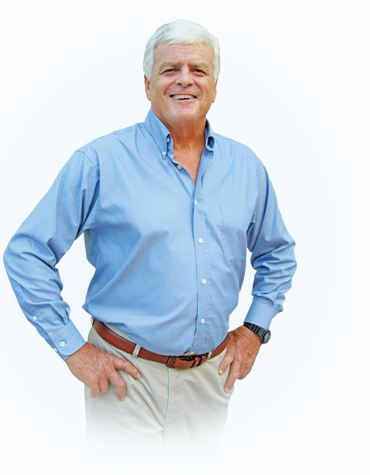By John Curtin Home Inspector
Content Approved and Protected
Per “The Sunshine State” Florida’s land mass is just over 42 million acers and 800,000 acres, or just under 2% of pristine wild Florida is contained in 161 Florida State Parks. At 11,500 acres Jonathan Dickinson State Park is the 12th largest on the list and was the 37th established park in the State’s history. The Everglades which is part of our Federal Park system adds another 1.5 million acers. 10 other Federal and hundreds of County parks compliment and complete Florida’s’ natural environments and amenities.
The War Years
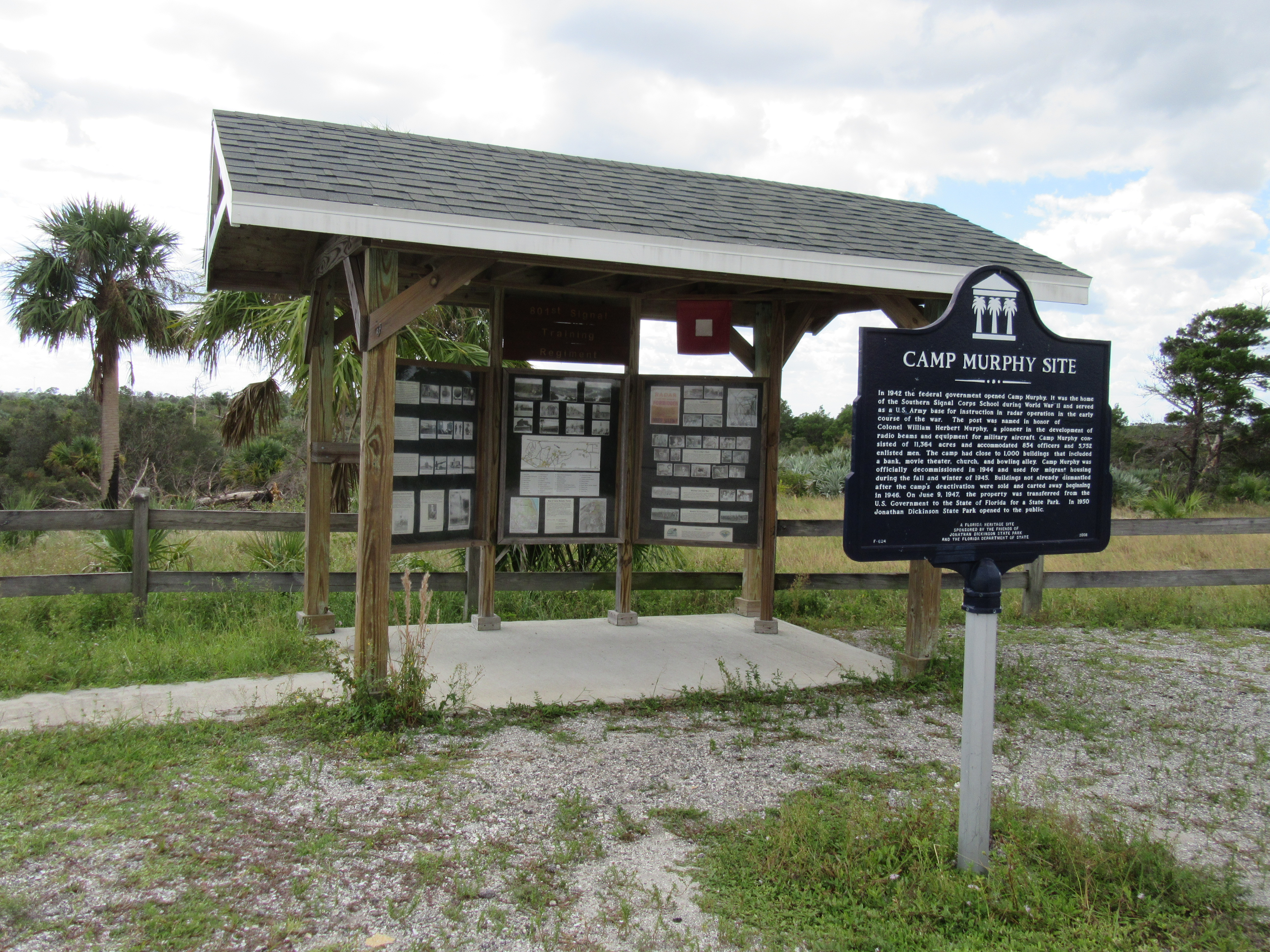
For the next 5 years appeasement continued and in the end of September, 5 months after Hitler invaded and annexed Austria on March 12, 1938, British Prime Minister Neville Chamberlain declared “Peace in Our Time” having reached an accord with Hitler on the division of sovereign Czechoslovakia. One year later on September 1, 1939 Hitler invaded Poland and Great Britain declared war the same day, honoring its military pledge of support and beginning World War II. While the United States remained “officially” neutral the winds of war were blowing In Europe and Asia with preparations for the inevitable being made in the homeland. On December 7, 1941, the day “Which Would Live in Infamy” Japan bombed Pearl Harbor and a day later the US declared war on The Axis Powers and the battle for supremacy was on.
One of the newest technologies of the time was Radar. Now that the US had officially entered the war we needed a location to fully develop this technology and train personnel without the prodding eyes of the clandestine “fifth columnists”. In April 1942 the United States Army Post: Camp Murphy was established on 11,000 acres of land between Jupiter and Hobe Sound. Within three months a fully operational base had been established with almost 6,000 enlisted men 900 officers and 400 buildings occupying the area between the Intracoastal and Flagler’s railroad. At the same time Jupiter’s population, had been cut to approximately 300 souls after nearly half had been drafted. Camp Murphy’s bustling operations brought great changes to Jupiter but in 1944 The Army decided to consolidate its operations at a base in New Jersey. After a short 23 months of operation The Signal Corps’ operations were moved and the base was closed. On September 2, 1945 Japan, formally surrendered ending World War II.
The Creation of the Park
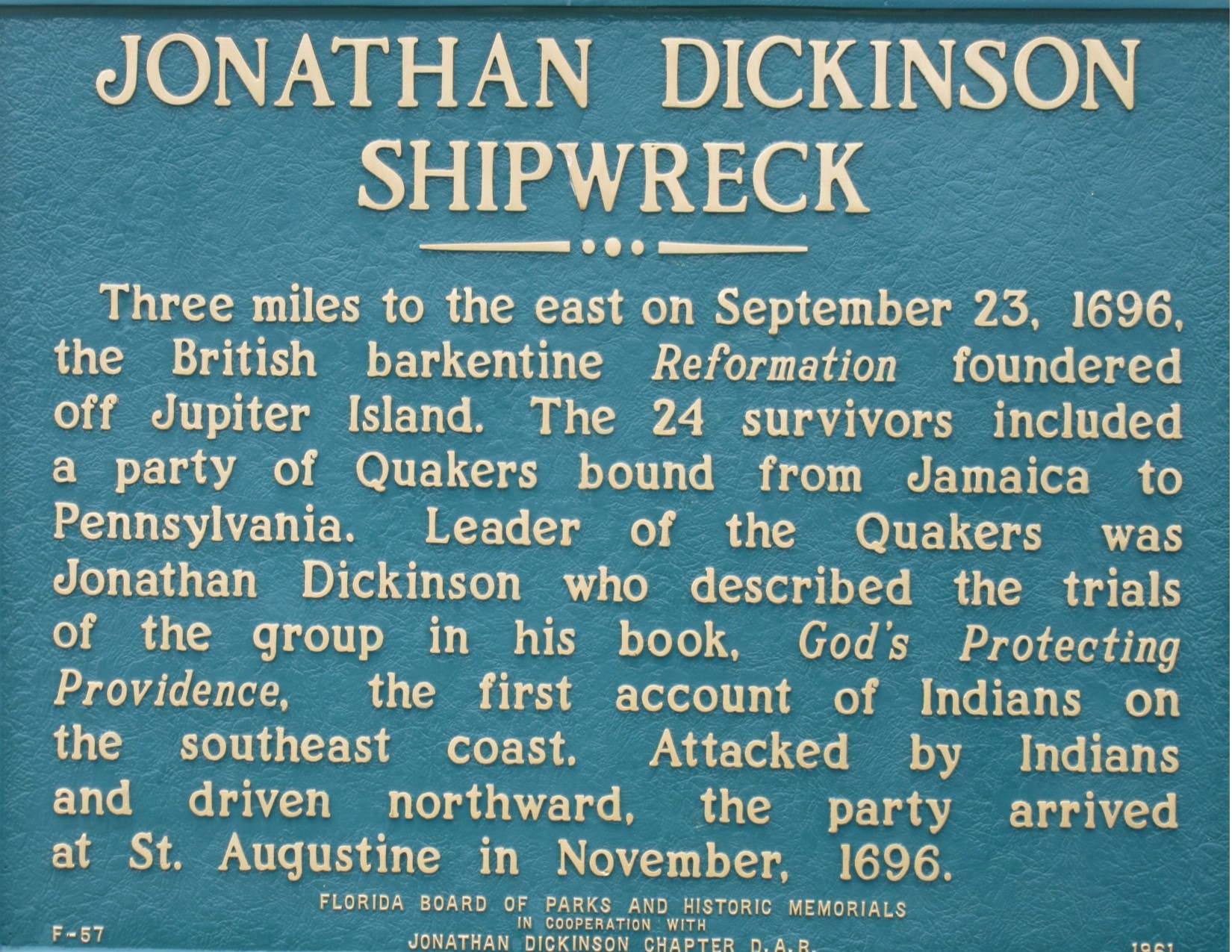 After years of debate and wrangling in the summer of 1947 the Florida Board of Forestry and Parks acquired 7,871 acres of the old Camp Murphy site. In 1968 the State began negotiations to acquire the 800+ acres that John “Trapper” Nelson owned around the Loxahatchee River on the Parks north boundary. Land trading and other negotiated agreements were finally reached in 1968, after Trappers death. In 1981 The Florida Legislature passed the “Save Our Rivers Act” which enabled the Park to acquire some 1,500 acres on the upper Loxahatchee. The land expansions were complete after the death of land developer John D MacArthur, in 1985; his Foundation donated 900 acres, and a similar sized parcel was also donated by the Nature Conservancy.
After years of debate and wrangling in the summer of 1947 the Florida Board of Forestry and Parks acquired 7,871 acres of the old Camp Murphy site. In 1968 the State began negotiations to acquire the 800+ acres that John “Trapper” Nelson owned around the Loxahatchee River on the Parks north boundary. Land trading and other negotiated agreements were finally reached in 1968, after Trappers death. In 1981 The Florida Legislature passed the “Save Our Rivers Act” which enabled the Park to acquire some 1,500 acres on the upper Loxahatchee. The land expansions were complete after the death of land developer John D MacArthur, in 1985; his Foundation donated 900 acres, and a similar sized parcel was also donated by the Nature Conservancy.
On September 22, 1696, the barkentine Reformation, bound for Philadelphia from Port Royal Jamaica, ran aground off Jupiter during a violent storm. The 24 passengers and crew all survived only to begin a harrowing journey of over 2 months and 230 miles up the virgin coast of Florida to St. Augustine. Beset by Indians and mother nature it is truly one of the great stories of courage and survival in the early Americas. The ship was commissioned by Jonathan Dickinson who was a Quaker merchant and he lead the survivors of the party to their eventual salvation. In 1938 Professor Charles W. Andrew was visiting Jupiter and after becoming aware of this great story of survival and with through research he published Jonathan Dickinson’s Journal in 1945. With the recently renewed interest in this great adventure it was considered to name the new park after Jonathan Dickinson.
The Park Today
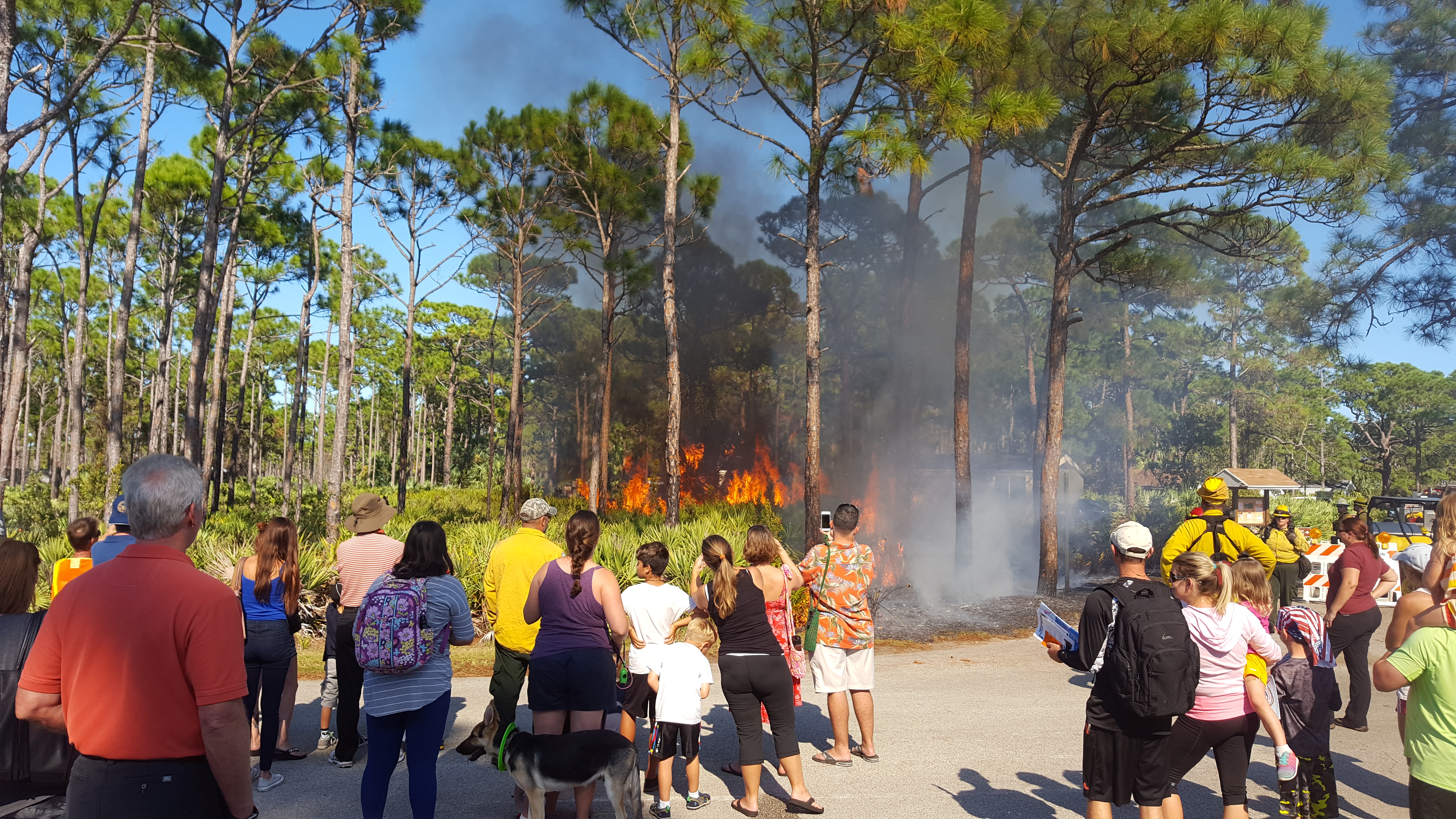 The Parks boundaries roughly encompass the area from Jupiter to Hobe Sound, from US Highway 1 to Interstate 95 and the lands along the Loxahatchee River to Indiantown Road. It includes the waters of the Federally Designated Wild and Scenic Loxahatchee River, sand hills and scrub on its east boundaries, flatwoods in the north, wet prairies in its middle and swamps and cypress domes in the south. Its ecosystem also hostess a varied and diverse plant community. The wild life is as broad boasting Deer, Wild Boars, Snakes, Otters, Alligators, Gopher Tortoise, The Florida Bobcat, Manatee, Osprey, Woodpeckers, Owls, Heron, Ibis, Snook and Mullet along with uncountable lesser mammals, birds, amphibians and fish.
The Parks boundaries roughly encompass the area from Jupiter to Hobe Sound, from US Highway 1 to Interstate 95 and the lands along the Loxahatchee River to Indiantown Road. It includes the waters of the Federally Designated Wild and Scenic Loxahatchee River, sand hills and scrub on its east boundaries, flatwoods in the north, wet prairies in its middle and swamps and cypress domes in the south. Its ecosystem also hostess a varied and diverse plant community. The wild life is as broad boasting Deer, Wild Boars, Snakes, Otters, Alligators, Gopher Tortoise, The Florida Bobcat, Manatee, Osprey, Woodpeckers, Owls, Heron, Ibis, Snook and Mullet along with uncountable lesser mammals, birds, amphibians and fish.
Don’t be alarmed if you see or smell smoke while traveling through the park. Through history the natural ecosystems were kept in balance by wild fires which were typically caused by lightning strikes. These fires are an important part of the parks life cycle as many of the plants seeds need the fire to germinate and its animals need the cleared lands to breed and hunt. Todays “Controlled Burns” are an important part of maintaining the parks natural balance and Eco diversity. In October, the park celebrates “Firefest” where over 2000 visitors celebrate the day with a multitude of events culminating in a spectacular night time demonstration burn.
The park is located at 16450 S.E. Federal Highway Hobe Sound, FL 33455 and you can contact the park at 772-546-2771. The park is open 7 days a week, 365 days of the year and is operated and maintained by its full-time staff of 25 and scores of dedicated volunteers. It’s variety of opportunity and experience for the visitor is as diverse as its ecosystem of flora, fauna and topography. For more information on Jonathan Dickinson State Park be sure to pick up James Snyder’s “A Visitors Guide to Jonathan Dickinson State Park” at the parks store. And visit Jonathan Dickinson State Park on the web at: www.floridastateparks.org/park/Jonathan-Dickinson
Following is a list of attractions and amenities which can be found at Jonathan Dickinson State Park:
 Unique attractions
Unique attractions
Friends of Jonathan Dickinson State Park
Trapper Nelsons Homestead, Zoo & Interpretive Site
Elsa Kimbell Environmental Education and Research Center
The Loxahatchee River
Hobe Mountain Observation Tower
Gator Overlook
Picnicking, General Store and Private Events
Camping
Car camping
Cabins
Group
Backcountry
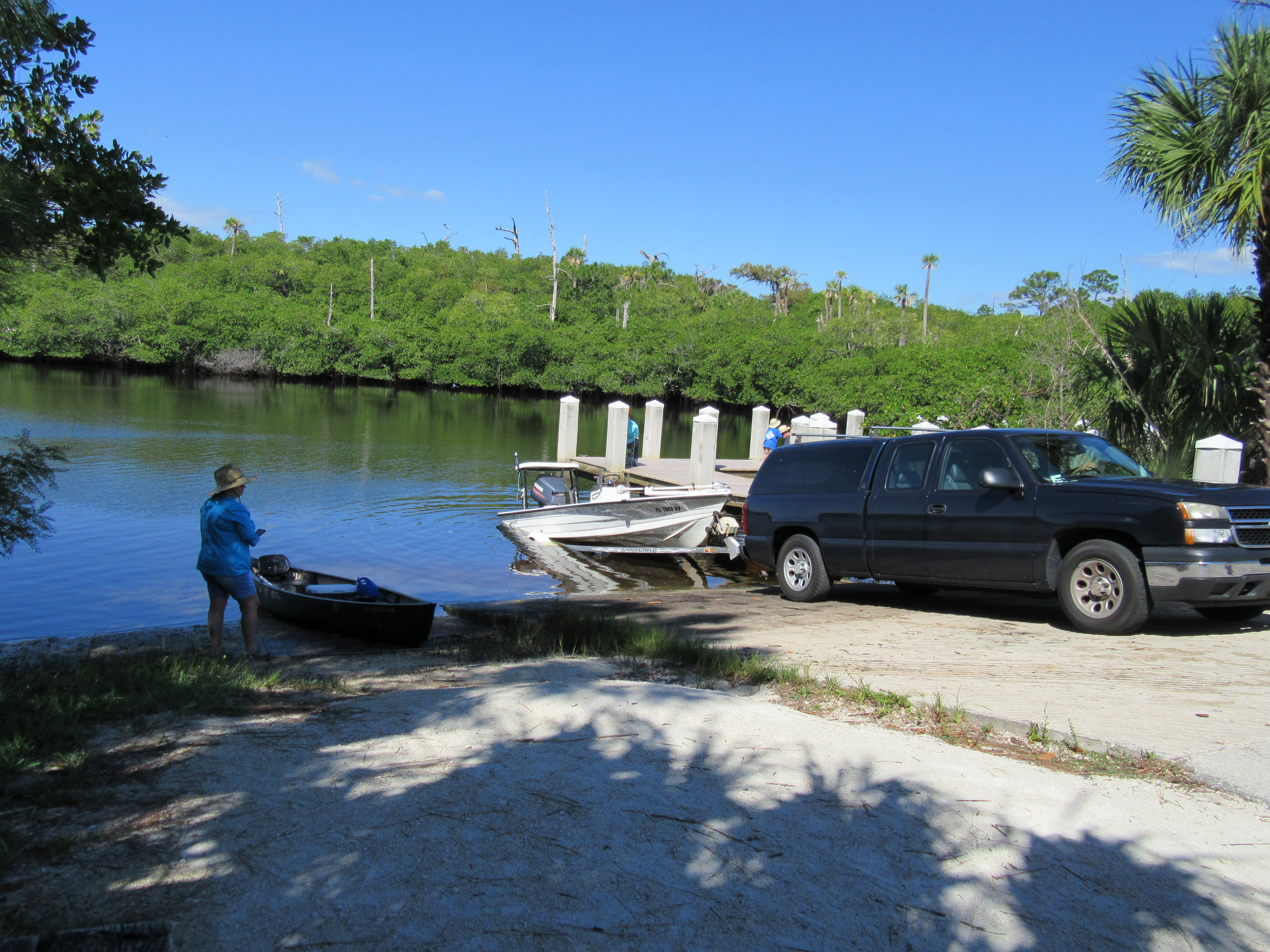 Boating
Boating
Rentals
Tours
Launch facilities
Motorboats up to approximately 20’
Kayaks and canoes
Small Sail Outriggers
Hiking
Backpack trails:
The Ocean to Lake Trail
The Ocean to Lake Multiuse Trail
The five-mile green loop trail
The 7.5 mile white loop trail
A Park Loop Trail
Eagles View Multi-Use Trail System:
Kitching Creek and Wilson Creek Trail:
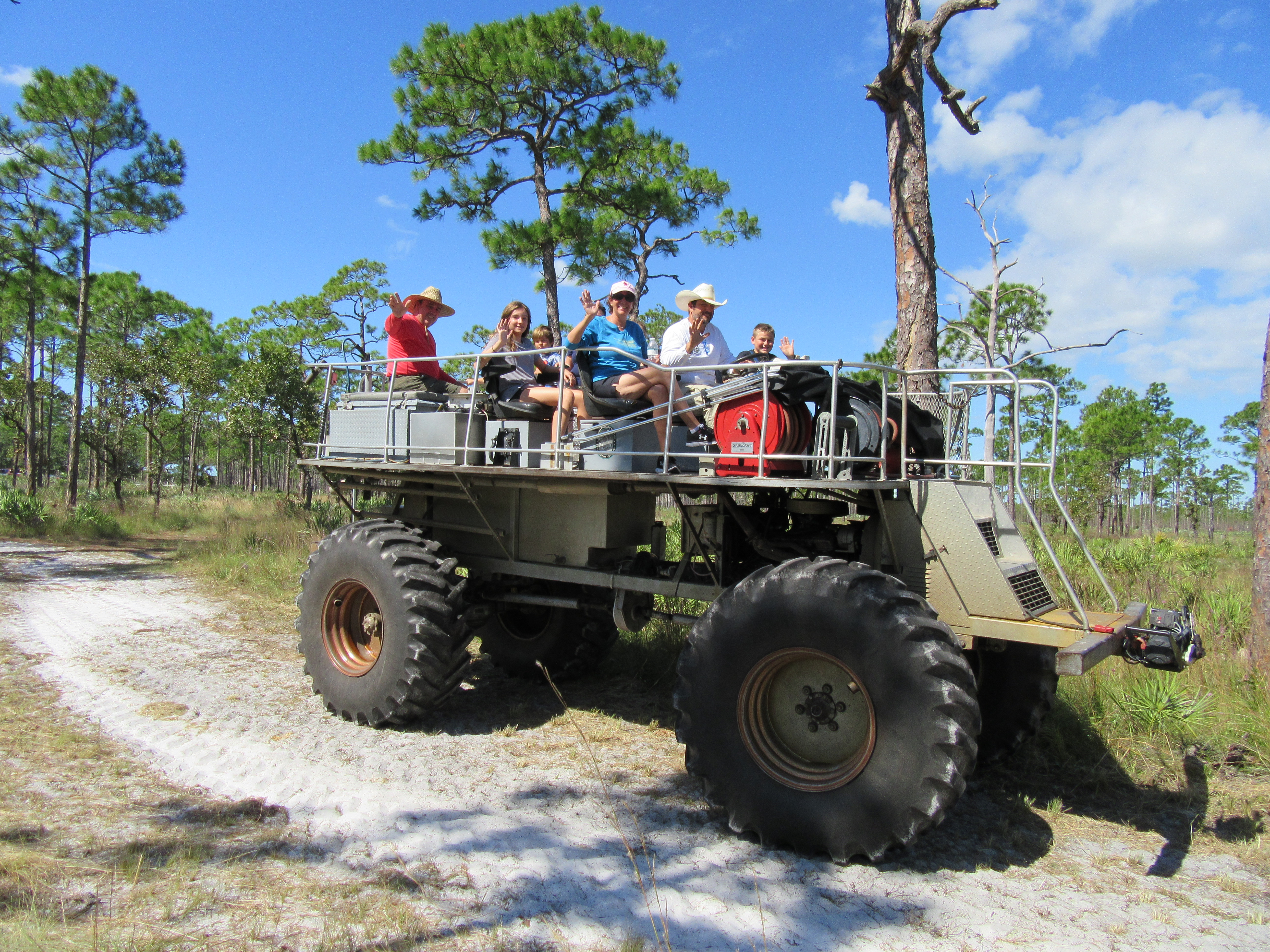 Horse and Swamp Buggy Rides
Horse and Swamp Buggy Rides
Guided trail rides
Horse-drawn Tram rides
Swamp Buggies
Biking
On Road
Camp Murphy Off Road Bike Trails and Paddle trips by Club Scrub.org
Swimming & Fishing
Unique attractions
Friends of Jonathan Dickinson State Park:
The Friends of Jonathan State Park, Inc. is a Citizen Support Organization (CSO). Its function is to serve as a source of financial support for the many physical needs the park has that are not already funded by the state. “The Friends” are a nonprofit organization that assists park management in meeting the natural and cultural resource management objectives established for the park. Jonathan Dickinson State Park is one of the most significant and diverse natural systems remaining in South Florida. Visitors have a variety of recreational opportunities including camping, picnicking, fishing, hiking, canoeing on the Loxahatchee River and much more. Please consider joining as a member of the “Friends” and enjoy the benefit of 12 free visits as part of your membership. We have social events through the year and special events for members to attend. There are also opportunities for volunteering. For more information and a calendar of events go to www.FriendsofJDSP.org
 Trapper Nelsons Homestead, Zoo & Interpretive Site:
Trapper Nelsons Homestead, Zoo & Interpretive Site:
Trapper Nelson came to the area in the 1930s and lived off the land by trapping and selling furs. He was a loner for the most part, who found security in this area and a way of life that was suited to his skills and temperament. He quickly became famous as the “Wildman of the Loxahatchee”. Yet, with his limited education, he managed to make a living, built a much-visited wildlife zoo and acquired large land interests. After his death in 1968, the state acquired his land, preserving his home and grounds for future generations to enjoy. Jonathan Dickinson State Park offers the unique historical site of Trapper Nelson’s. Over the years, he built log cabins, a Seminole Indian “Chickee” shelter, a wildlife zoo and planted lush tropical gardens for visitors to enjoy. The Loxahatchee Queen II docks at the Trapper Nelson site where passengers are met by a Park Ranger who guides them through the cabins and grounds once belonging to the “Wildman of the Loxahatchee.” Or you can canoe to the site and picnic under the “Chickee” shelter and then leisurely stroll the area on a self-guided tour. This site is accessible only by the water. For more information on Trapper Nelson visit: http://jchomeinspector.com/our-area/47-the-history-of-trapper-nelson
Elsa Kimbell Environmental Education and Research Center:
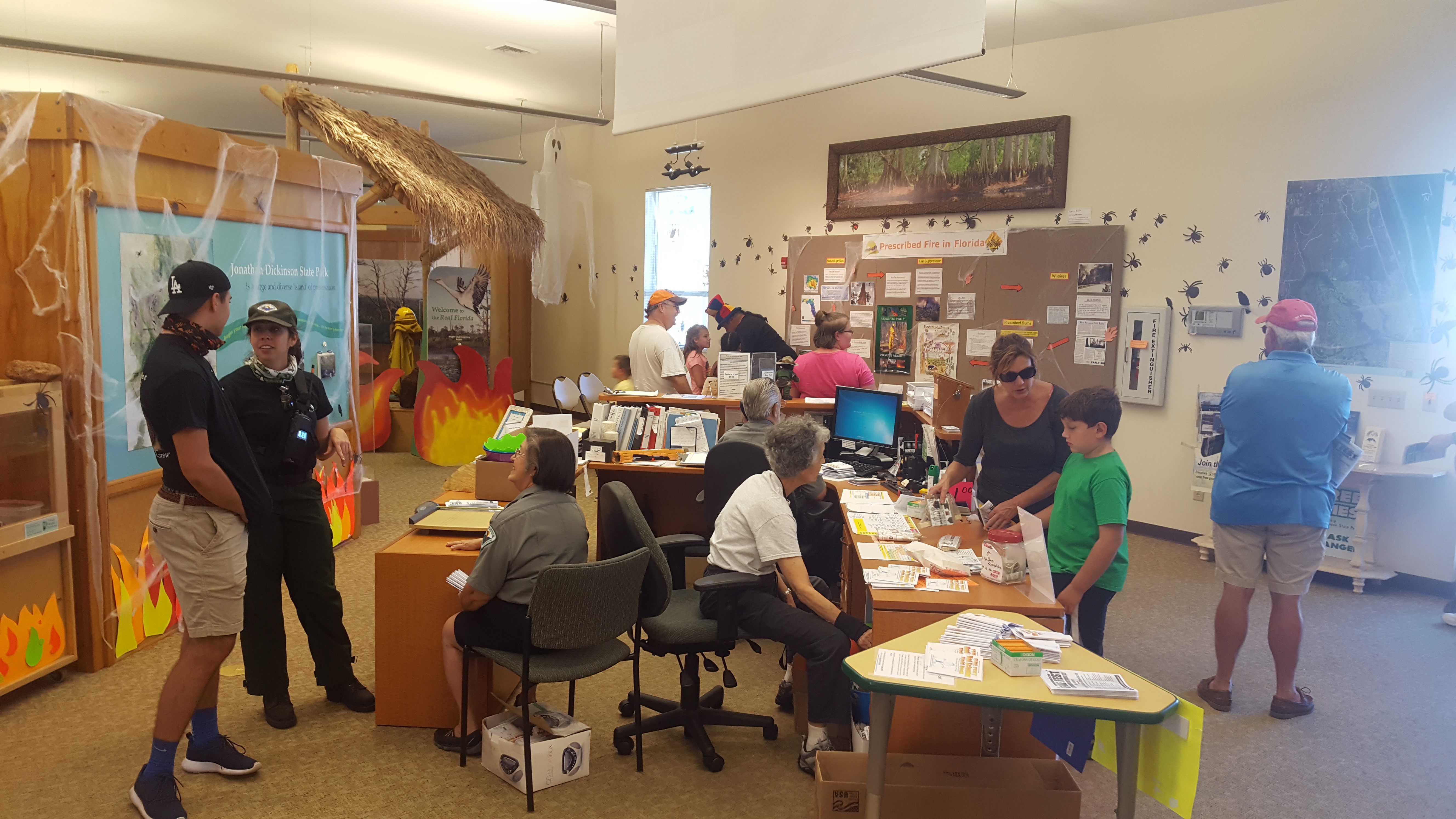 Named after the past president and founder of The Friends of Jonathan Dickinson State Park the center was opened in 2006 and is in the Riverfront area of the Park. The center offers interactive dioramas depicting the parks history, natural ecosystems, flora and fauna. There are attractions geared for adult and children alike. The facility also offers a conference center and meeting room and often holds presentations such as floral exhibits, discussions by naturalists and talks by the area’s leading historians.
Named after the past president and founder of The Friends of Jonathan Dickinson State Park the center was opened in 2006 and is in the Riverfront area of the Park. The center offers interactive dioramas depicting the parks history, natural ecosystems, flora and fauna. There are attractions geared for adult and children alike. The facility also offers a conference center and meeting room and often holds presentations such as floral exhibits, discussions by naturalists and talks by the area’s leading historians.
The Loxahatchee River:
In 1977 to Jupiter Tequesta Women’s Club, witnessing the unprecedented growth in the area, undertook saving the Loxahatchee from development and thus permanent loss. In 1985 their tireless work and vision saw the United States Congress, through the National Park Service, designate the Loxahatchee River as one of our 208 National Wild and Scenic Rivers. Paddling east to the headwaters of the Loxahatchee is a trip that the eminent author James Snyder vividly described in his book “5000 Years on the Loxahatchee”. It’s narrow meandering bands, varied currents, giant Cypress, fern and plant covered banks, varied wildlife and the occasional alligator, morning hints of the sun’s angled rays awakening the day and glistening off the leaves dew and rising mists remind one more of a time when dinosaurs roamed then of theme parks, golf courses and restaurants.For mor informatin on navigating and exploring the waters of the Loxahatchee see; http://www.jchomeinspector.com/our-area/46-where-to-kayak-and-paddle-board-around-jupiter
Hobe Mountain Observation Tower:
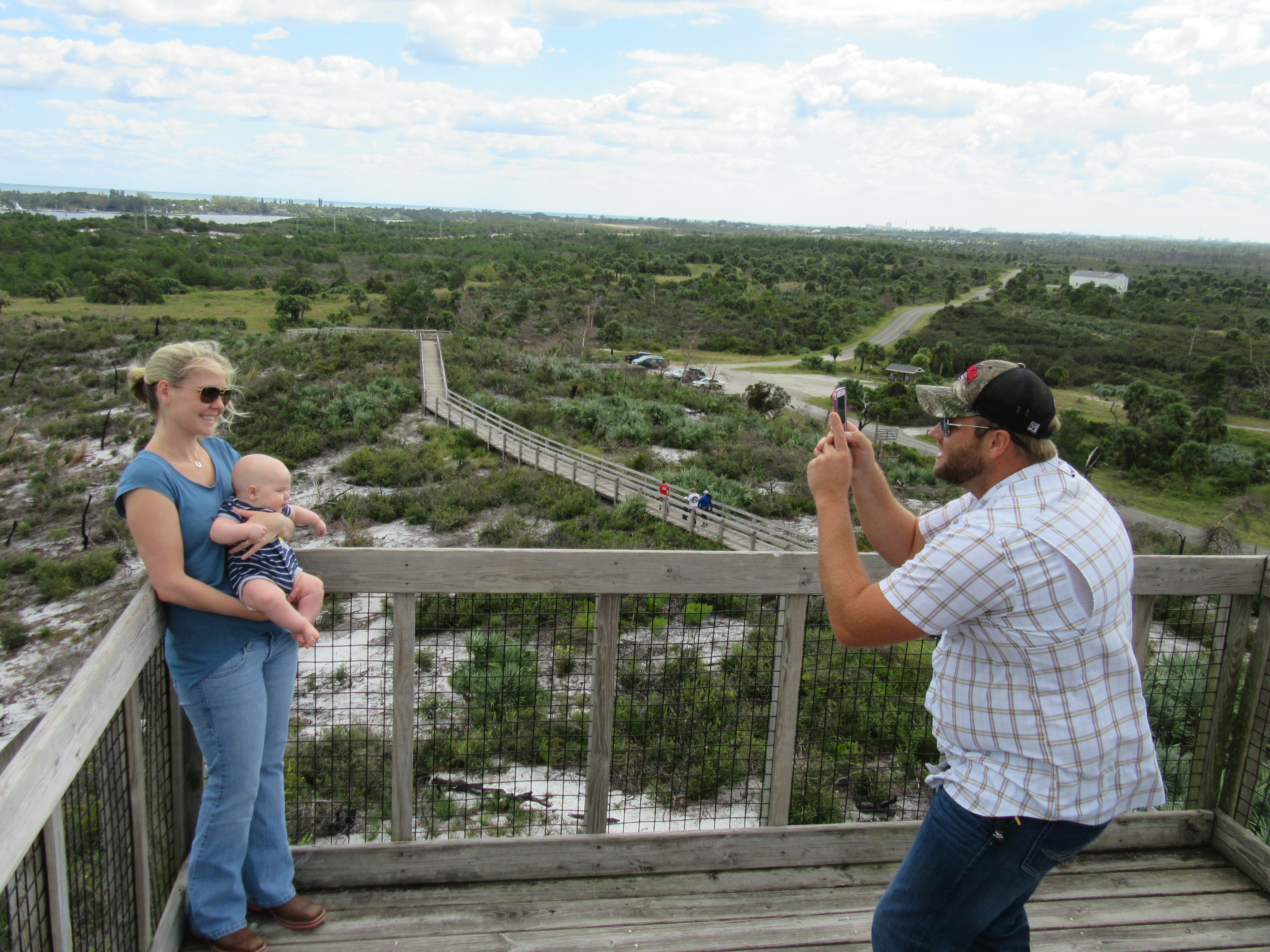
Gator Overlook:
On the Park’s main road, halfway between the entrance and the Riverfront facilities, it crosses the beginnings of a small river. At this location there is a roadside parking area and a short boardwalk which leads to the rivers headwaters. Looking down from the fenced wooden overlook is a great place to observe alligators, and sometimes their offspring, in their natural habitat, from a safe distance
Picnicking, General Store and Private Events:
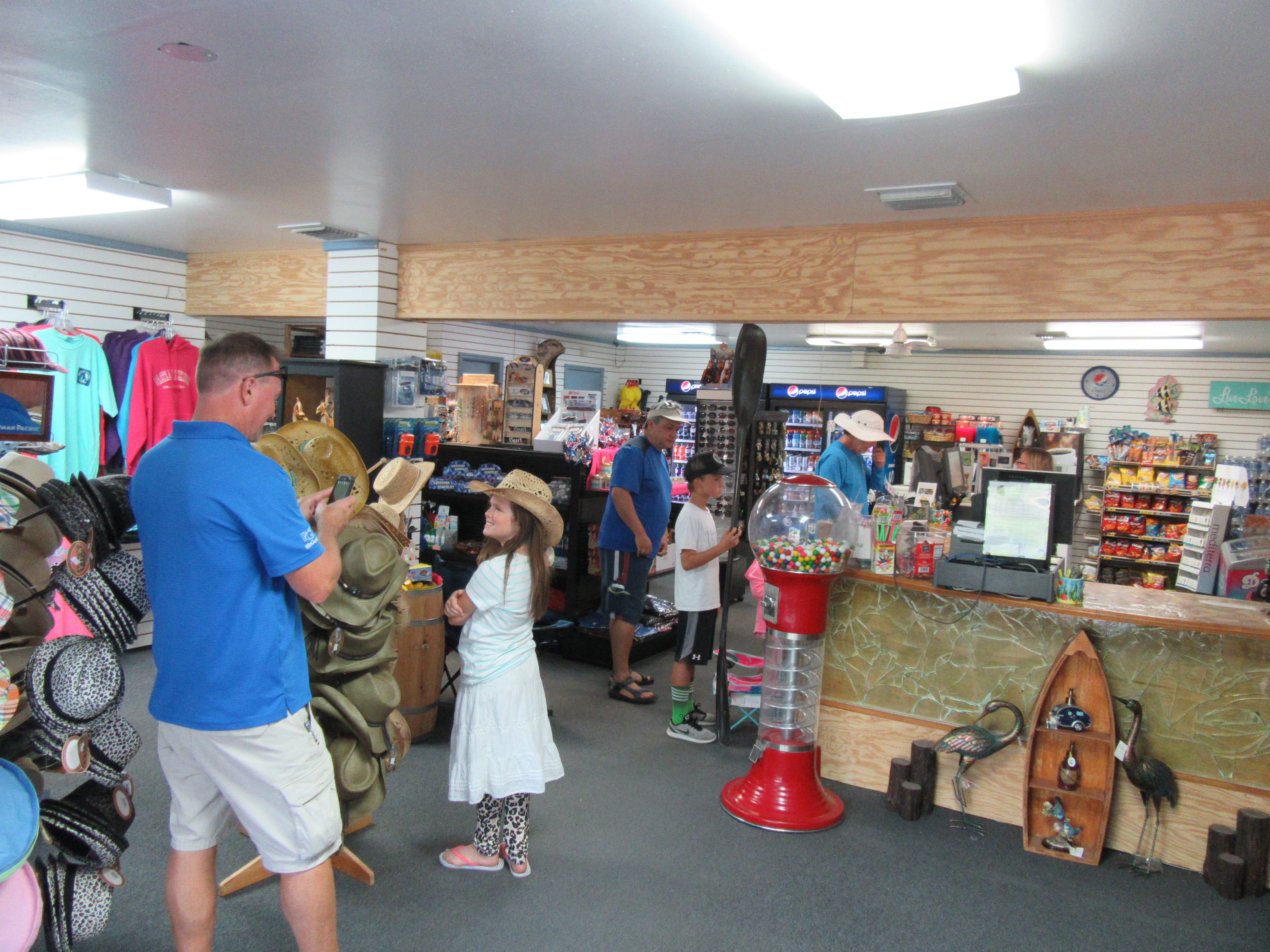
Camping:
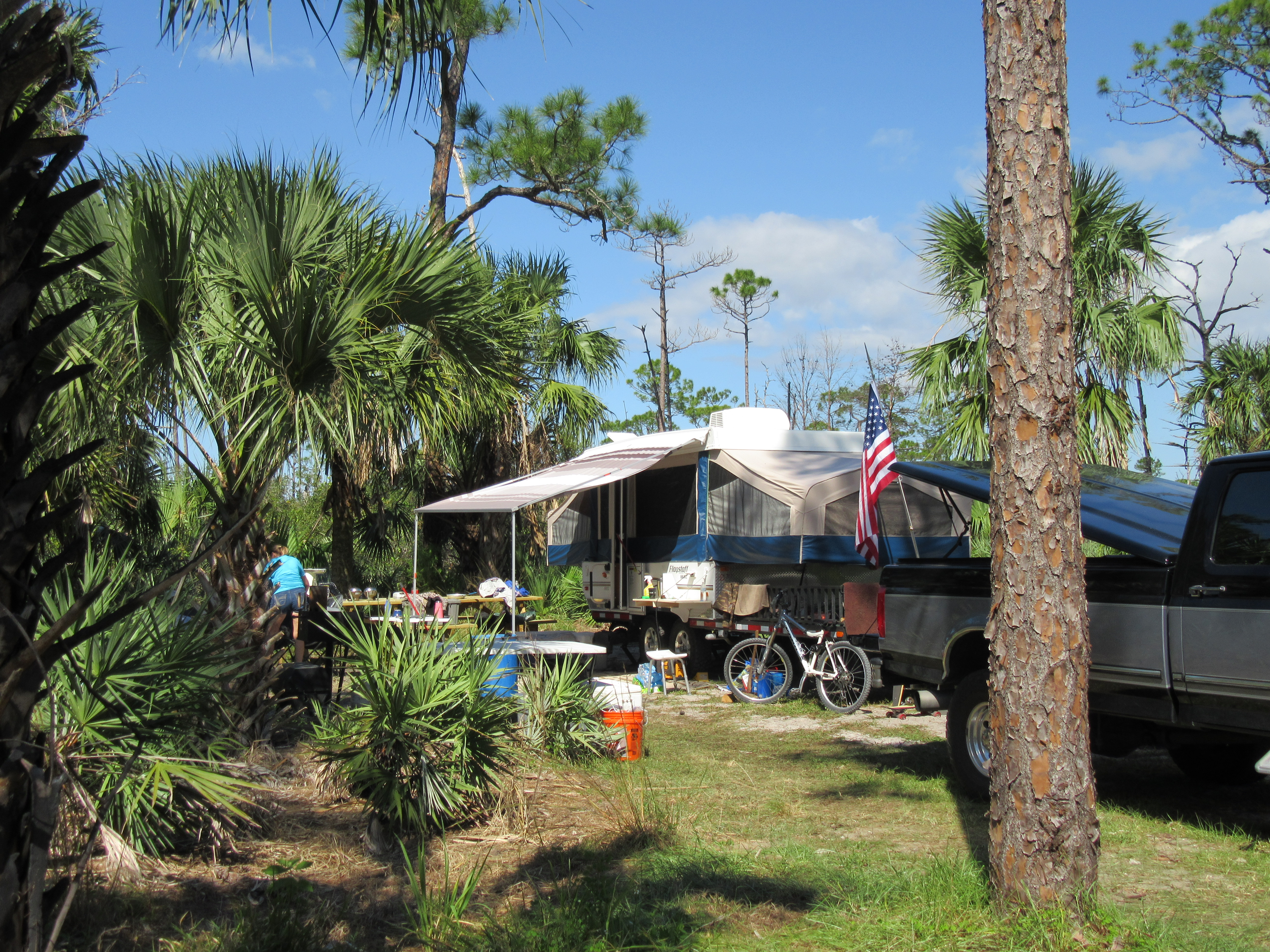
Cabins: Not far from the Riverfront there are 12 cabins which offer air-conditioning and cooking amenities.
Group: A large primitive group camping area offers facilities for scouts, churches and other similar organizations
Backcountry: There are two backcountry campgrounds on the trails. In the north there is the Scrub Jay Campsite and in the west Kitchen Creek Campsite which offer remote and primitive camping for hikers. These facilities offer a cleared area, primitive fire ring, out-houses and hand pump wells with water which must be purified. These are leave no trace areas where everything you carry and has to be packed out.
Boating:
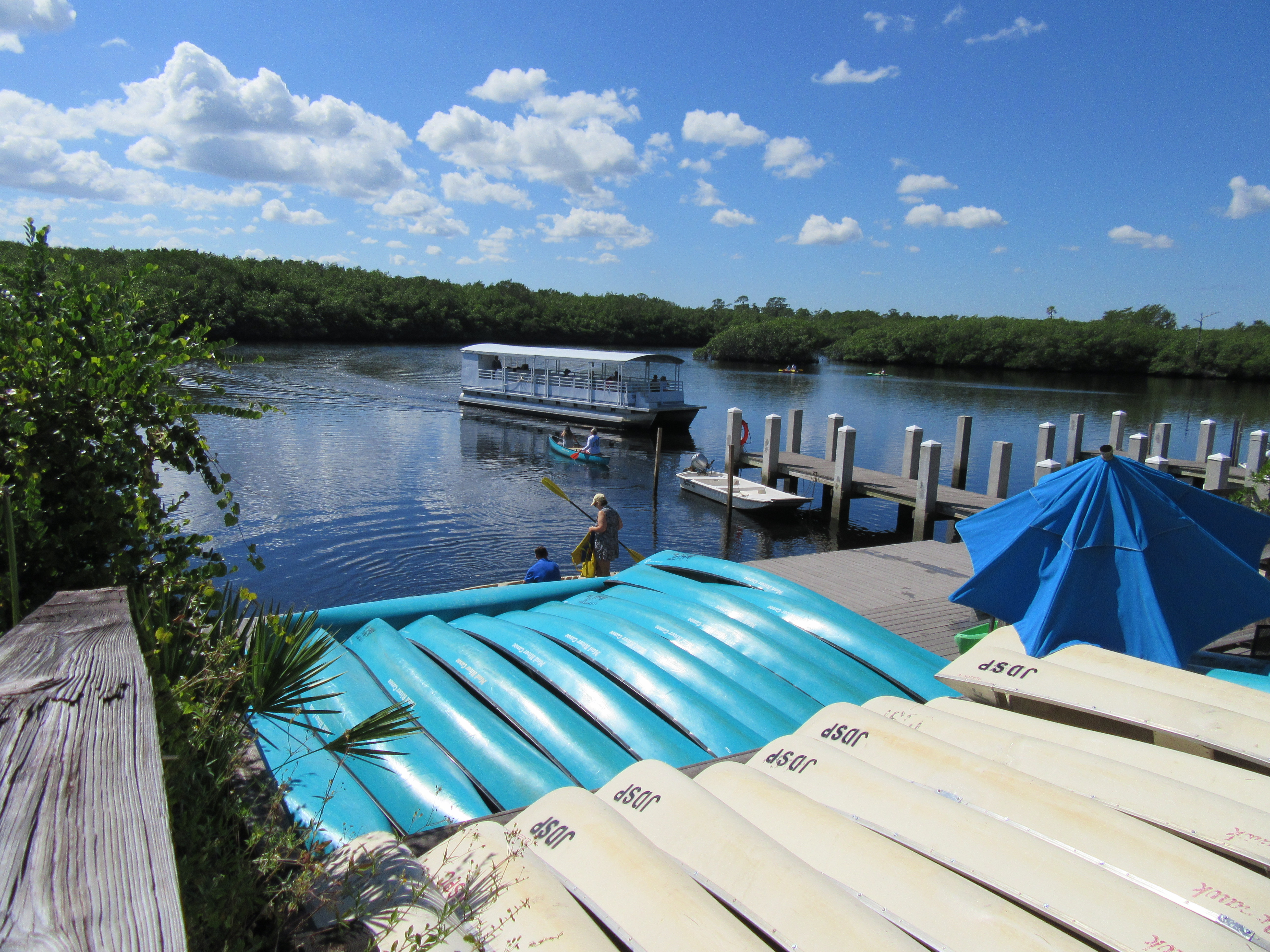
Rentals: At the Parks Riverfront facility kayak’s, canoes and small motorboats can be rented for individual and unsupervised travel on the river.
Tours: A 30 passenger pontoon boat embarks from the Parks Riverfront facility on a regular basis offering guided and interpretive tours of the river. The highlight of the tour is an excursion through Trapper Nelson’s Riverfront Historic campsite / homestead and zoo.
Launch facilities: Private watercraft can be launched at the developed and paved ramp near the river Campground.
Motorboats up to approximately 20’ can be lunched and navigate the rivers waters to the Atlantic which is 7 miles to the east and west to Trapper Nelson’s camp which is approximately 5 miles up the narrowing river.
Kayaks and Canoes can navigate another 4 miles upriver and west of Trapper Nelsons Camp to Palm Beach County’s Riverbend Park and also on a short and remote section of Kitching Creek which is approximately 1 mile west of the launch area.
Small Sail Outriggers can navigate the waters adjacent to the Parks riverfront and the adventurous and experienced can attempt a trip to Trappers Camp.
Hiking:
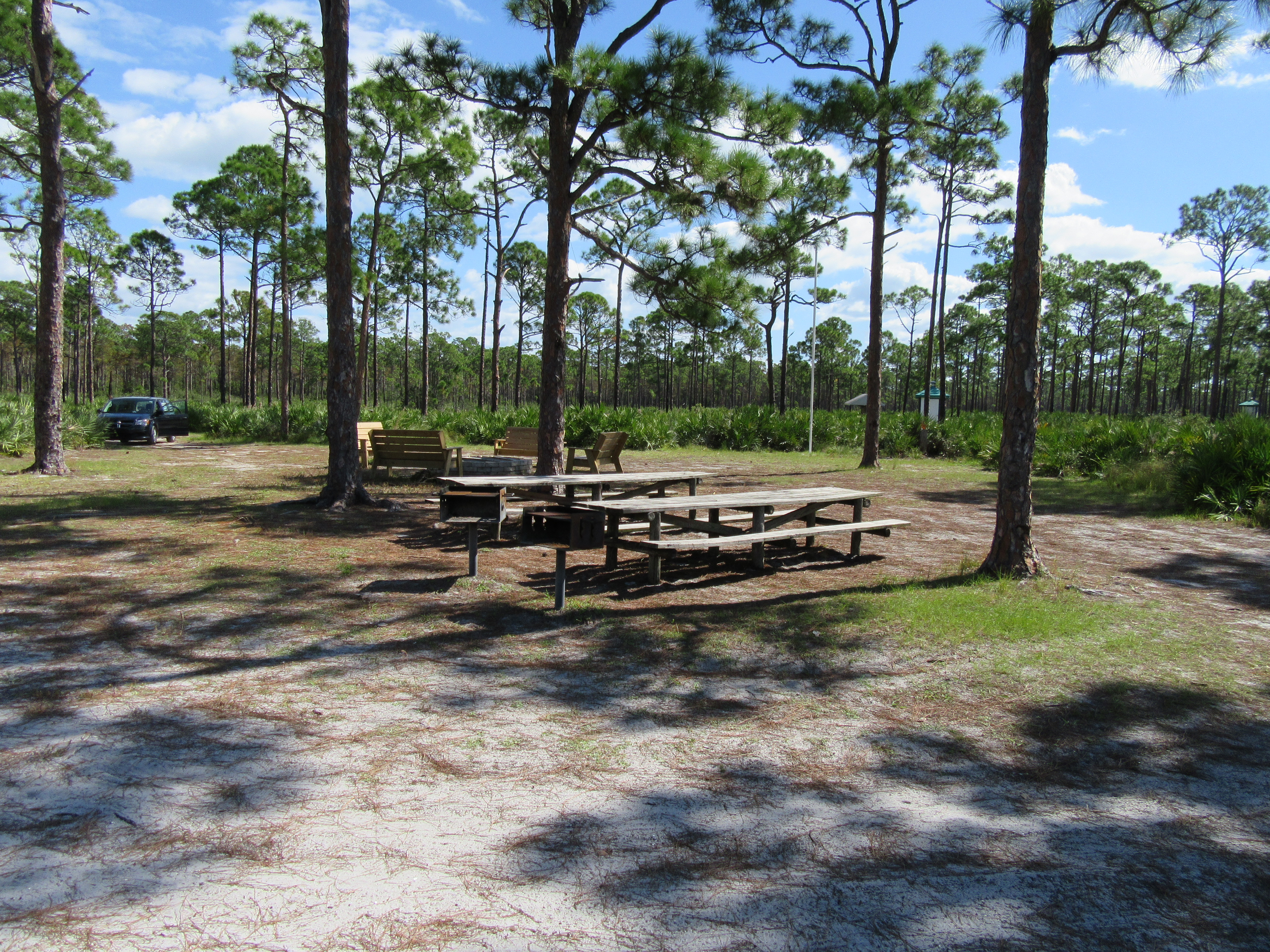 Backpack trails
Backpack trails
The Ocean to Lake Trail (orange blazes) on the Intercoastal just south of Hobe Sound at the north end of the park and travels 70 miles to Lake Okeechobee. For 15 miles it traverses the western portion of the park from north to south. The trail can be started on US one where it crosses over the railroad tracks south of Hobe sound or on Indiantown Road and Jupiter Farms just west of Jupiter Farms Road across from the McDonald’s in the shopping center. The ocean to Lake Trail is marked with white blazes.
The Ocean to Lake Multiuse Trail (rainbow blazes) follows a roughly similar path within the park but allows horses and off-road biking in addition to hikers
The five-mile Green Loop Trail (green blazes) starts in the parking lot at the park’s entrance heads north along US one and returns to the park entrance along the railroad tracks. This trail is marked with green blazes.
The 7.5-mile White Loop Trail (white blazes) traverses the northern middle east section of the park with trailheads just west of where the Parks Road crosses the railroad tracks and again approximately three quarters of a mile further down the road. White blazes are noted on the trees where it crosses the road. Approximately 1 mile of the trail is south of the Park Road with the remainder looping back north of the Park Road.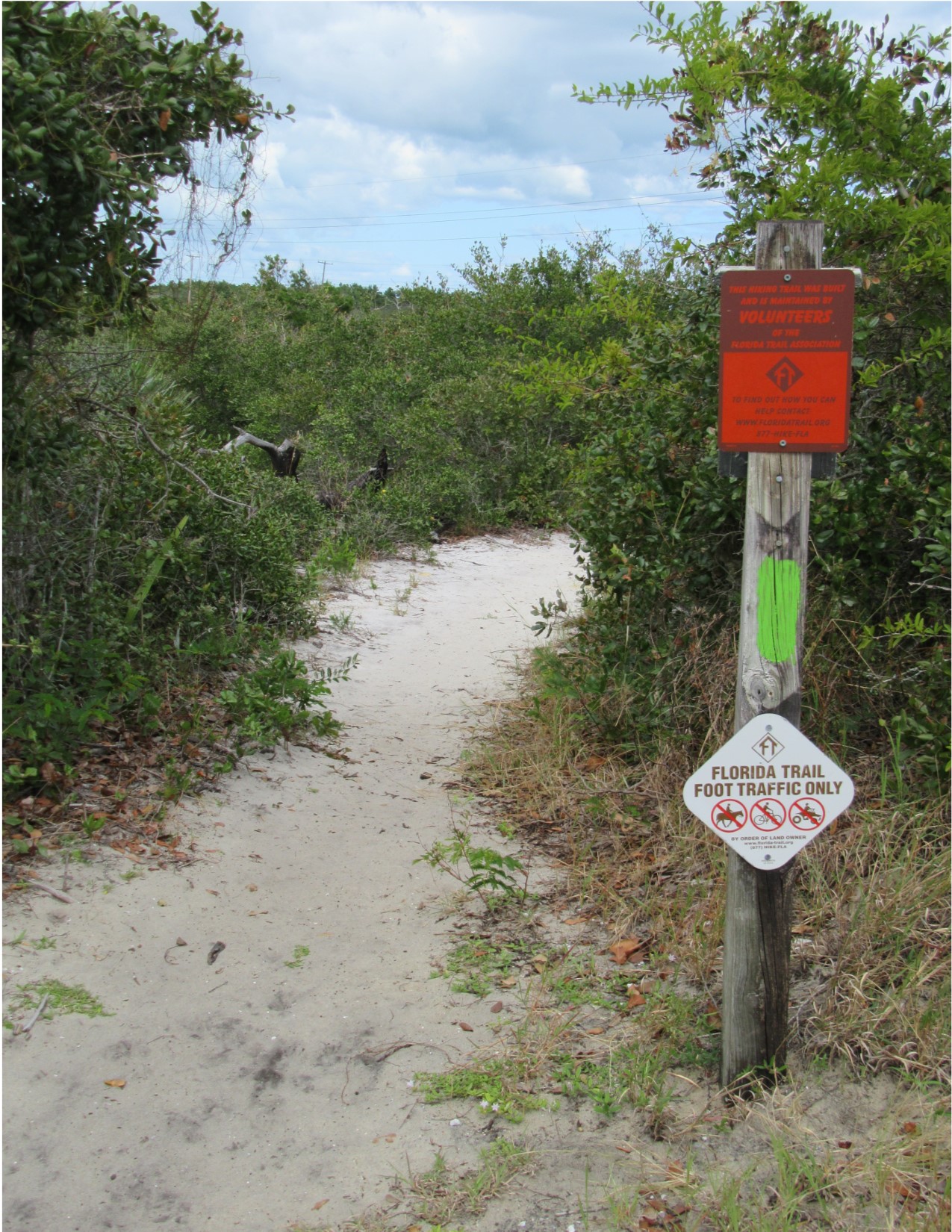 A Park Loop Trail of roughly 15 miles can be put together by starting at the Park entrance lot and heading north on the Green Loop Trail to where it meets the railroad tracks continue north along the tracks and encountering the Ocean to Lake Trail at the north end of the park. The Ocean to Lake Trail can then be followed on a south westerly root until it encounters and crosses Kitching Creek. At that point you would had south before the Creek on the Eagle View Multiuse System. Combining the Eagle View system and a short section of undesignated trail following Kitching Creek will bring you to the west end of the Kitching Creek Trail System. Proceeding east on the trail you will end up at the trail head in the west parking lot at the Riverfront center of the Park. From this point you can walk the road or hitchhike back to your car at the front entrance parking lot. The two Back Country Camp Sites will be passed along this rout.
A Park Loop Trail of roughly 15 miles can be put together by starting at the Park entrance lot and heading north on the Green Loop Trail to where it meets the railroad tracks continue north along the tracks and encountering the Ocean to Lake Trail at the north end of the park. The Ocean to Lake Trail can then be followed on a south westerly root until it encounters and crosses Kitching Creek. At that point you would had south before the Creek on the Eagle View Multiuse System. Combining the Eagle View system and a short section of undesignated trail following Kitching Creek will bring you to the west end of the Kitching Creek Trail System. Proceeding east on the trail you will end up at the trail head in the west parking lot at the Riverfront center of the Park. From this point you can walk the road or hitchhike back to your car at the front entrance parking lot. The two Back Country Camp Sites will be passed along this rout.
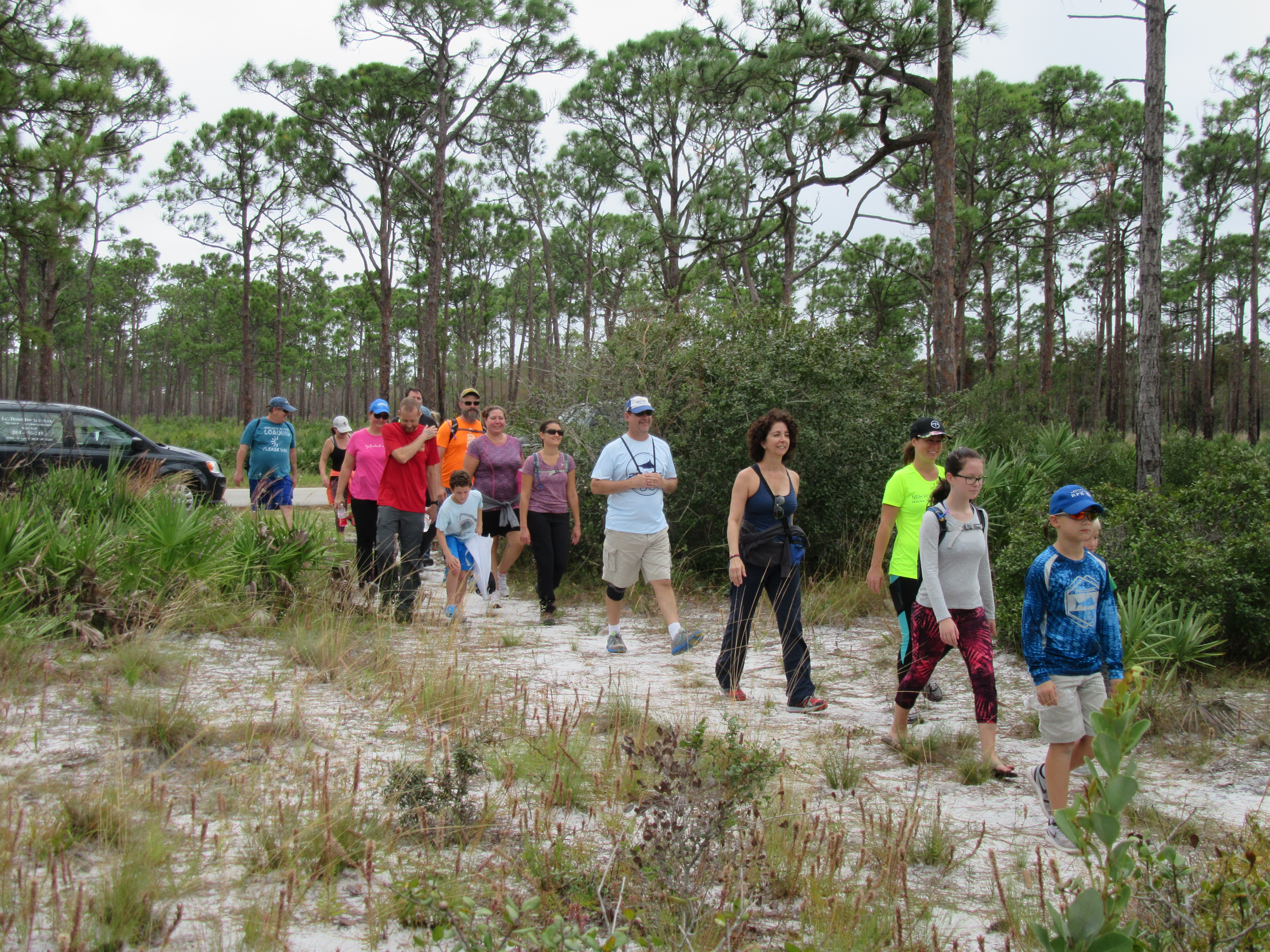
This this system of trails is approximately 8 miles and was originally designated for equestrian use although now walkers and off-road bikers also use it with the understanding that horses have priority. The marked trail system starts at the equestrian center heading north along the power line then turns south to form a roughly 3 ½ mile circle ending back at the power lines. Three other marked trails crisscross the center of the circle. The trails are roughly 10 feet wide and are covered with mowed grass which can get to 6 inches high in some areas. They wander through wet flat woods of tall grass, Palmetto Palms averaging 4 foot in height and a scattering and of slash pines. There are dips and culverts in the trail which in the rainy season can fill with water up to a depth of a foot or more. Other unmarked trails encounter this system which can take you south to the Kitching Creek area and deeper into the Western part of the park. Care should be taken to stay on the marked trails and not get lost. A GPS device is helpful.
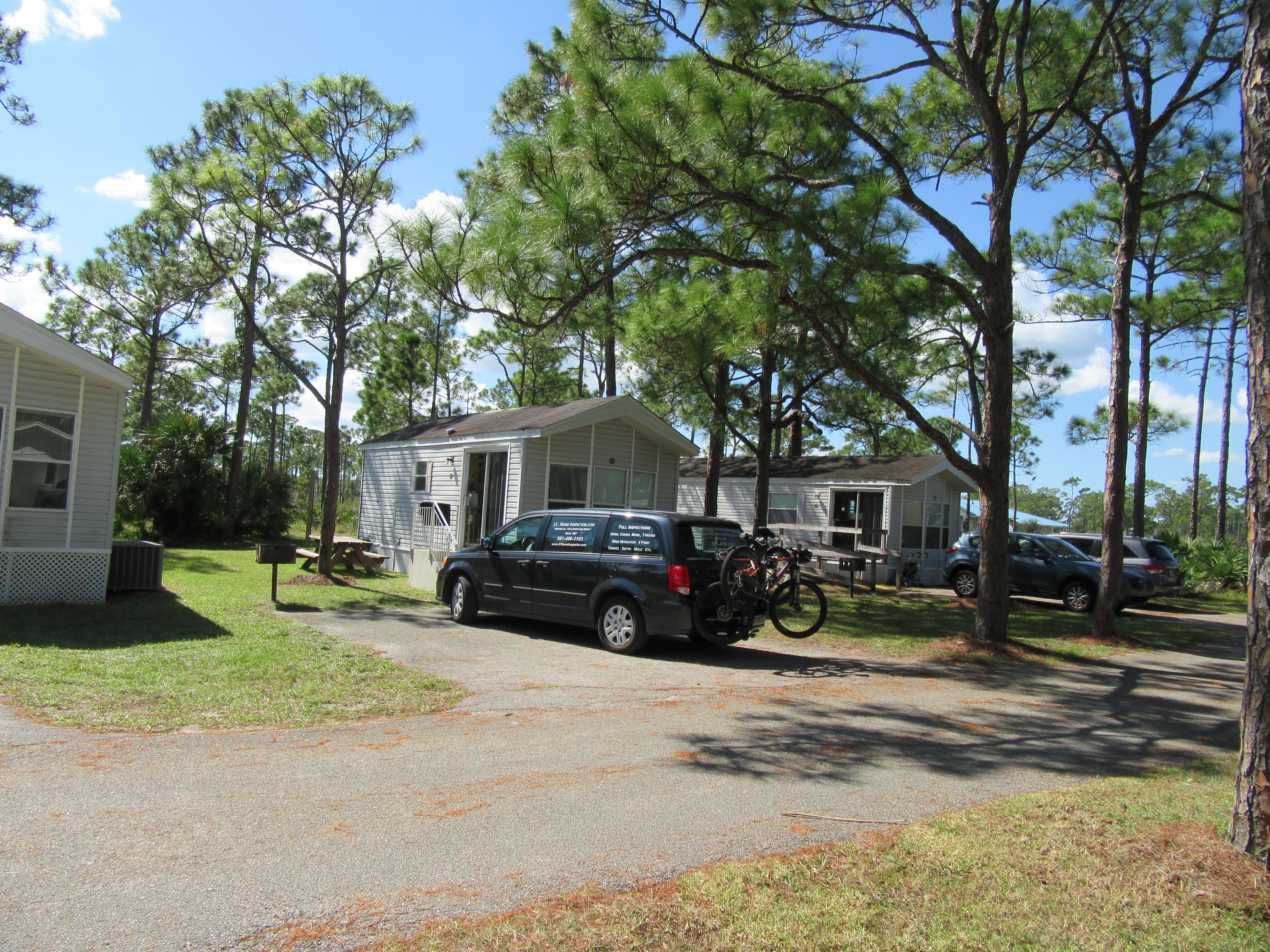
Theses short loop interpretive trails starts at the far end of the western most parking lot at the Riverfront area of the Park. Both trails are broad and flat and meander mostly through tall grass, Palmetto Palms averaging 4 foot in height and a scattering of pine trees. In the rainy season and after heavy storms the trail can be muddy. A box at the trailhead offers a brochure which explains the flora and fauna encountered along 12 designated sites on the trail.
The Wilson Creek Trail is short loop of which takes approximately ½ hour and heads west from the parking lot, traverses the Wilson Creek, heads south along its bank, then crossing back over the river and returning to the parking lot.
The Kitching Creek Trail starts at the same location but after crossing Wilson Creek continues west to Kitching Creek where there is a wooden overlook. The trail then returns to the parking lot via a more southerly route. This hike takes about an hour.
Horse and Swamp Buggy Rides:
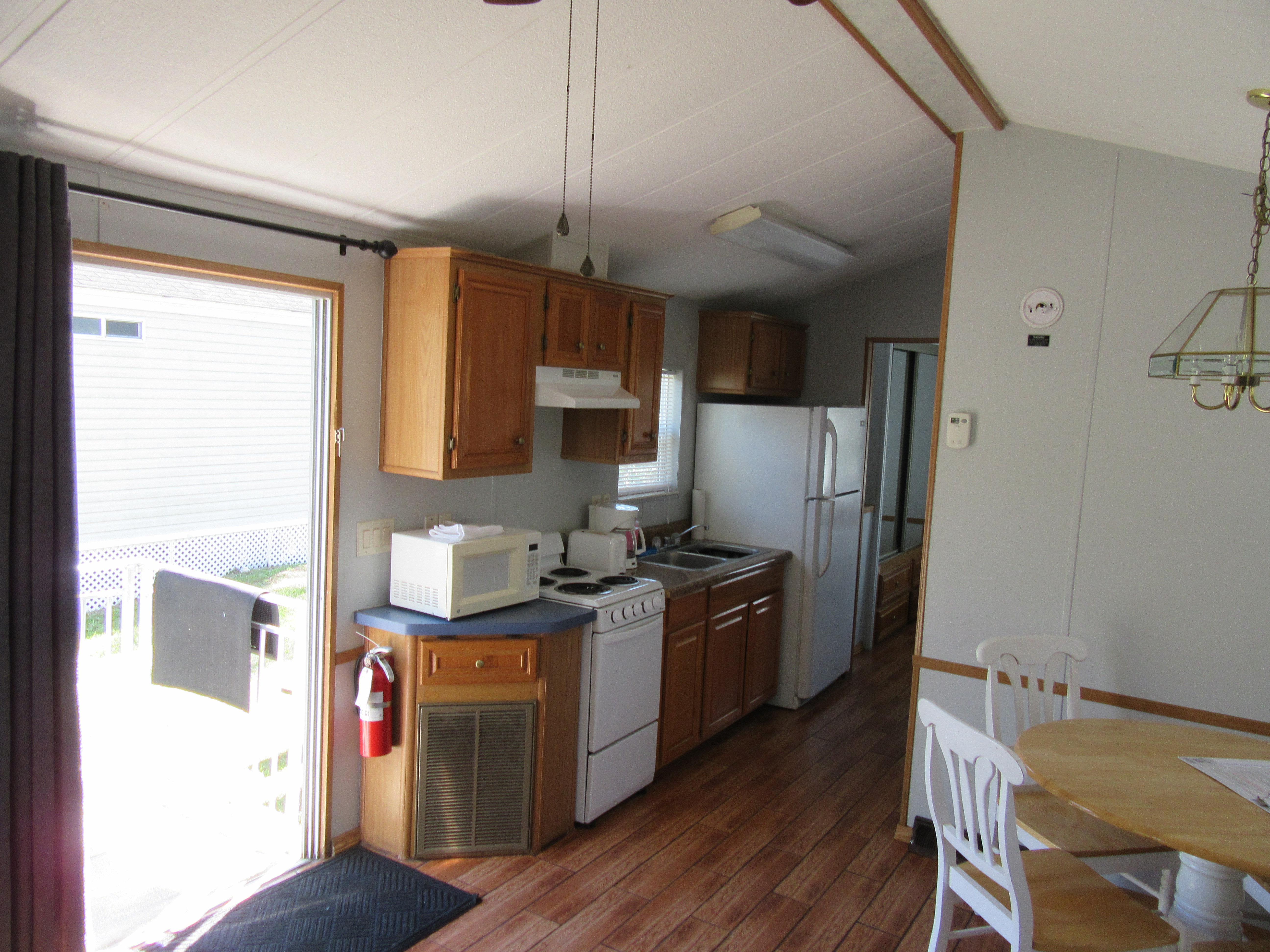
Horse-drawn Tram rides depart continually throughout the day and have no weight or age limit. Due to the popularity of the Horse-drawn Tram rides, reservations will not be accepted. All rides are subject to weather and trail conditions.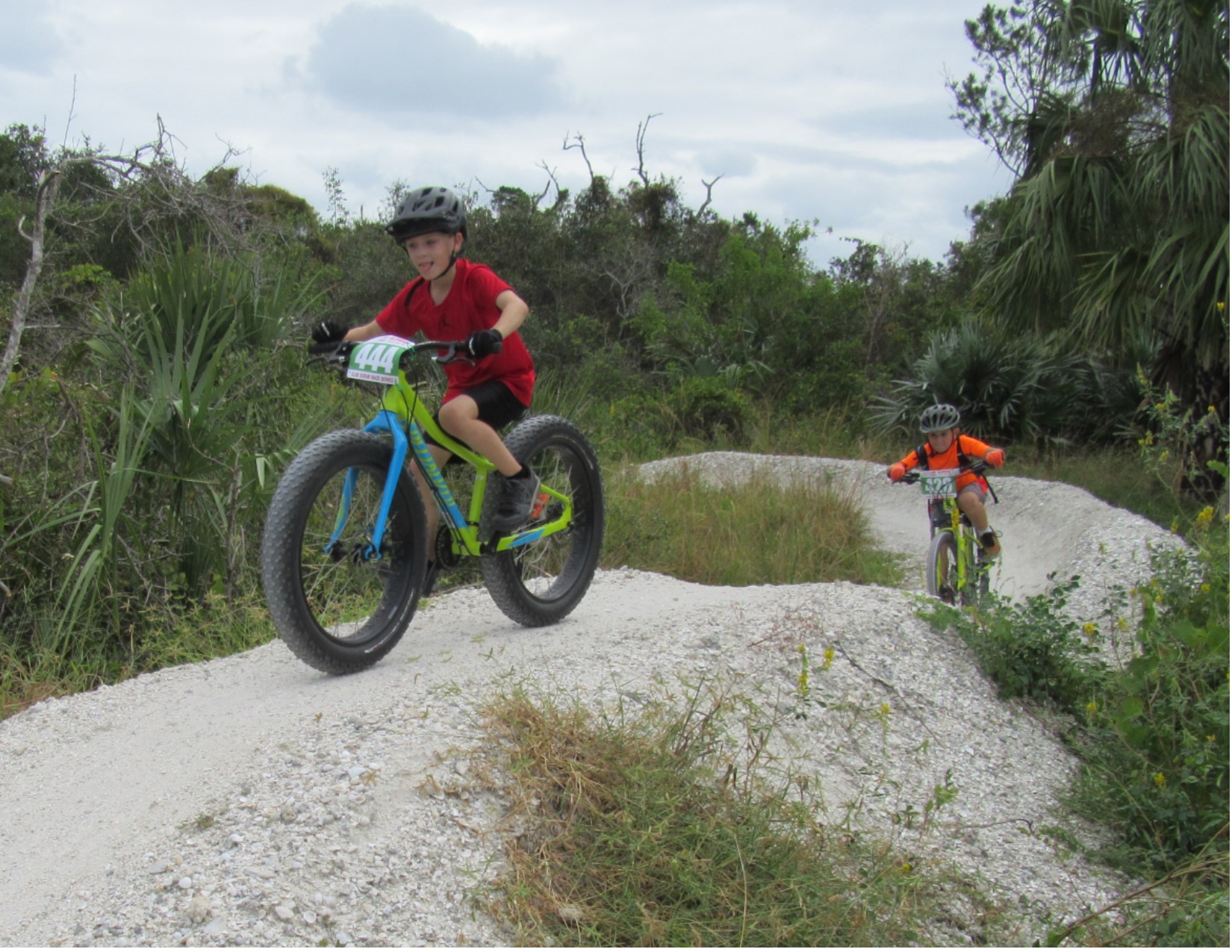 Swamp Buggy Rides leave from the Kimbell Center and travel for approxomatly 1 hour through the back country of the park. Schedueling can vairy and should be aranged by contacting the Kimbell Center.
Swamp Buggy Rides leave from the Kimbell Center and travel for approxomatly 1 hour through the back country of the park. Schedueling can vairy and should be aranged by contacting the Kimbell Center.
Biking:
On Road: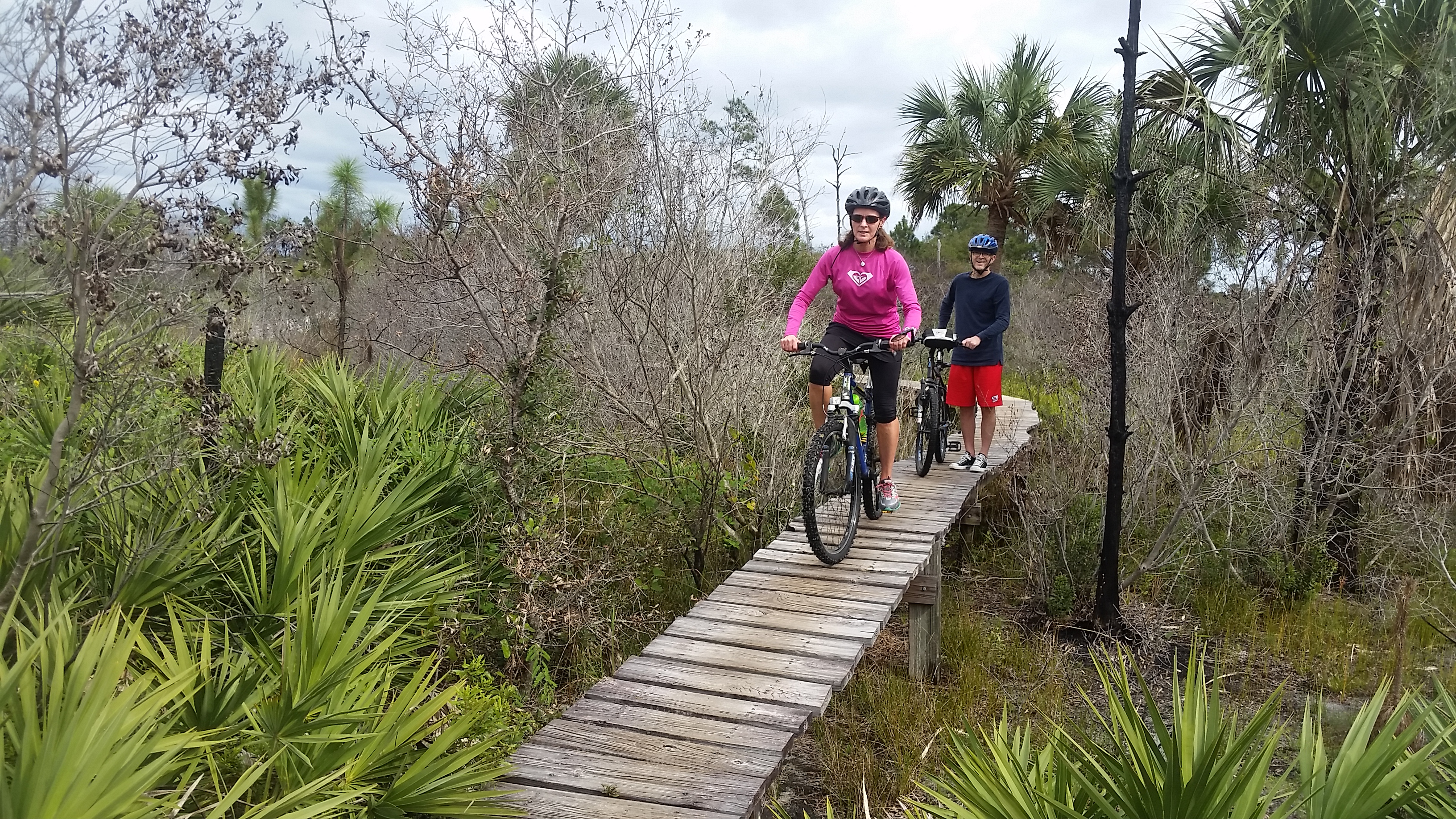 The approximately 15 miles of paved road within the Park offer the cyclist and their families an enjoyable and safe way of experiencing most of the parks environments. From its sand dune and scrub lands in the east, through the flatwoods and prairie in the middle to Riverfront in the west. One can also take a short side trip to the Hobe Mountain Observation Tower. The paved Flatwood Trail which winds through the woods a distance from the road offers a more secure route for the younger and less adventurous. It is a pleasant 4 miles round-trip from the Riverfront to the Equestrian area and back. This trail is scheduled to be extended to the main entrance of the park in the not so distant future. Around the perimeter of the camp Murphy off Road bike trails there are approximately 2 miles of older unmaintained paved roads which were part of the military base. Motorized traffic is not allowed on these roads. Future plans along with the extension of the Flatwood Trail also include adding approximately 2 ½ miles of paved bike and hike way along the right-of-way of the Florida East Coast Railway.
The approximately 15 miles of paved road within the Park offer the cyclist and their families an enjoyable and safe way of experiencing most of the parks environments. From its sand dune and scrub lands in the east, through the flatwoods and prairie in the middle to Riverfront in the west. One can also take a short side trip to the Hobe Mountain Observation Tower. The paved Flatwood Trail which winds through the woods a distance from the road offers a more secure route for the younger and less adventurous. It is a pleasant 4 miles round-trip from the Riverfront to the Equestrian area and back. This trail is scheduled to be extended to the main entrance of the park in the not so distant future. Around the perimeter of the camp Murphy off Road bike trails there are approximately 2 miles of older unmaintained paved roads which were part of the military base. Motorized traffic is not allowed on these roads. Future plans along with the extension of the Flatwood Trail also include adding approximately 2 ½ miles of paved bike and hike way along the right-of-way of the Florida East Coast Railway.
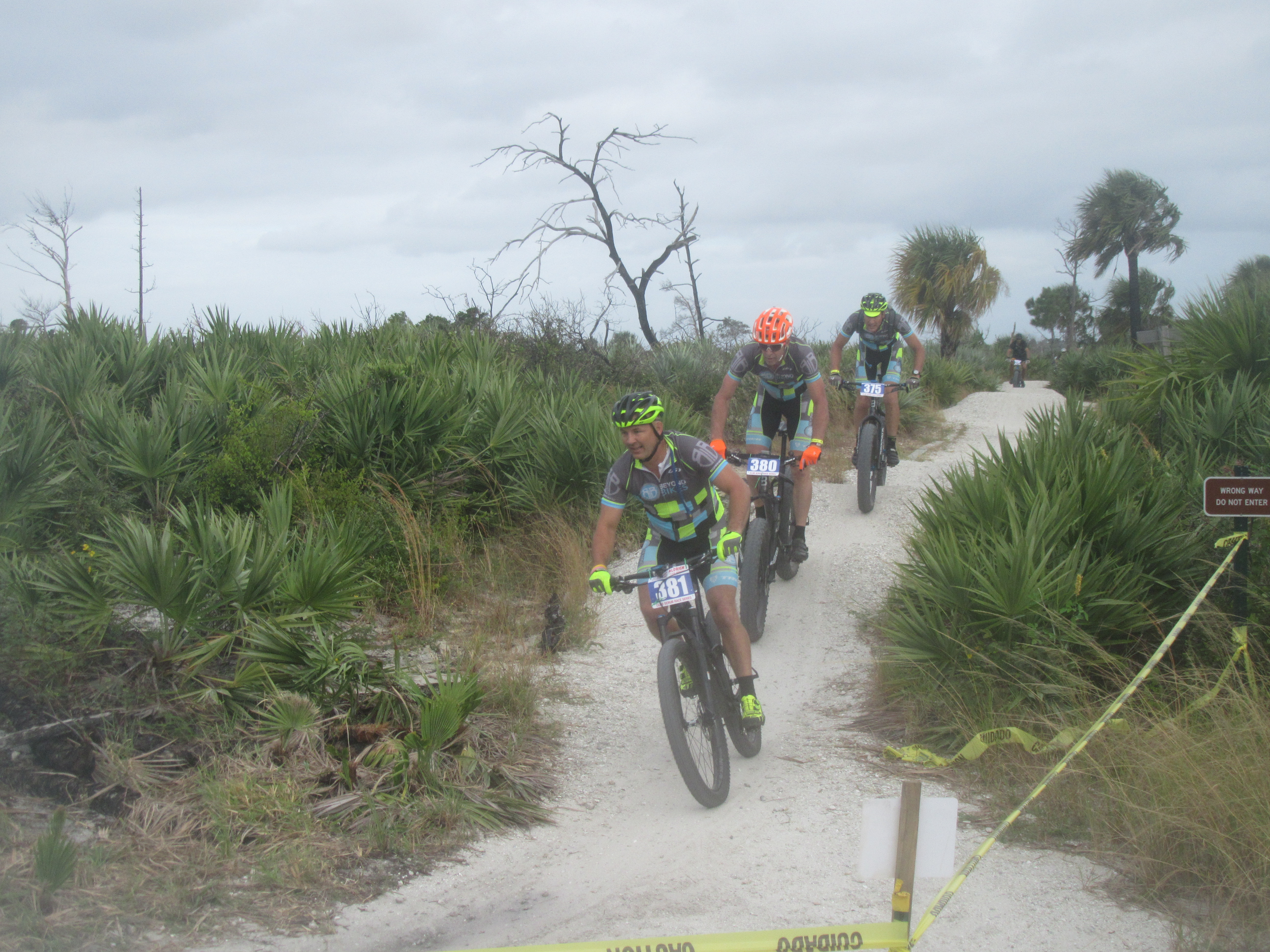
The Camp Murphy Off Road Bike Trails were initially laid out shortly after the founding of the park. In May of 2000 Club Scrub was formed as a special committee operating under The Friends of Jonathan Dickinson State Park www.FriendsofJDSP.org. In 2014 Dorsey Tennant and Juliana Catalfumo met and joined forces to reinvigorate Club Scrub. With Dorsey spearheading trail development and maintenance and Juliana organizing events and membership Club Scrub has grown from approximately 40 people in September 2014 to more than 950 families in 2016.
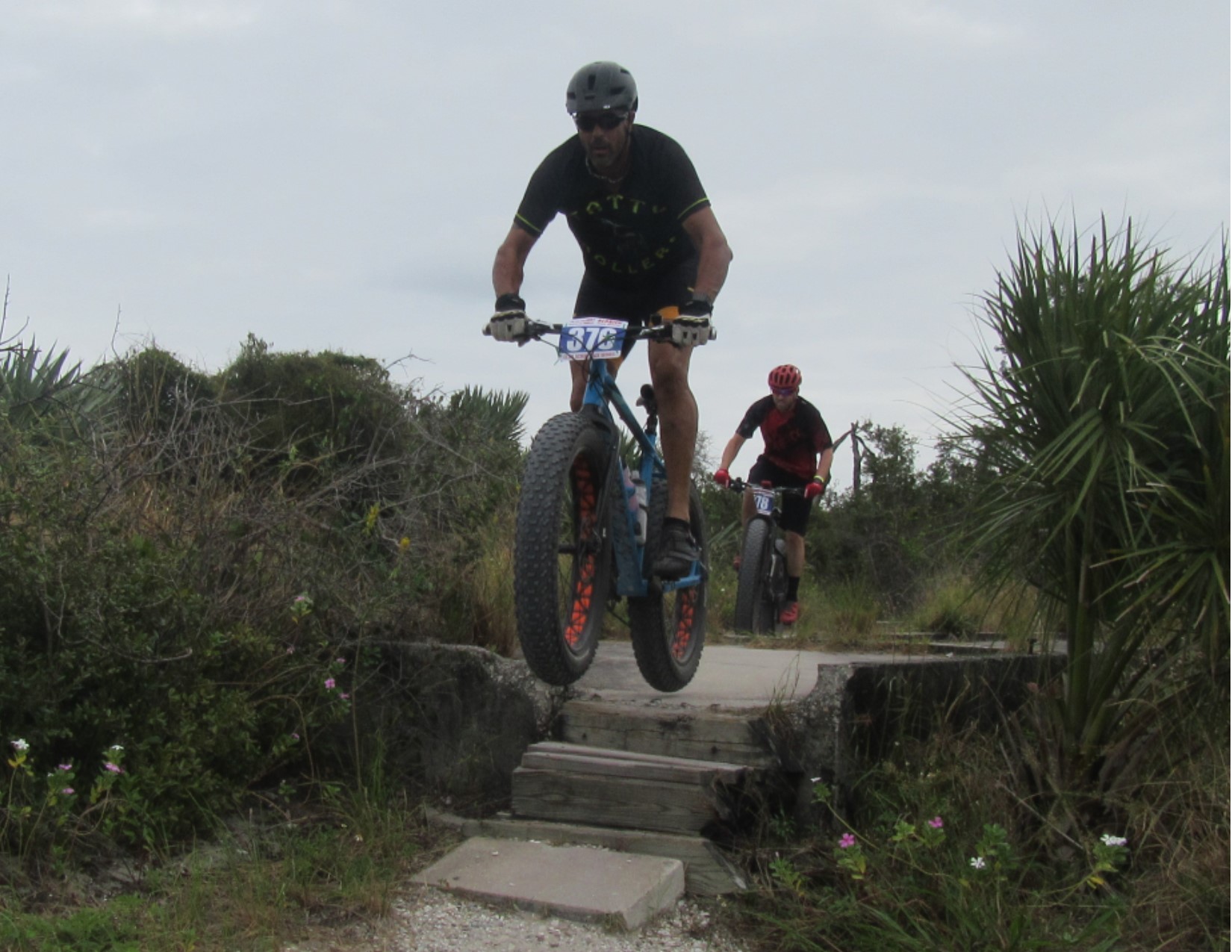 There are over 10 miles of trail, and growing, which range from novice to expert in their degree of challenge and difficulty. Although primarily built on rolling sandy soil Dorsey and his dedicated crew of volunteers have laid tons of rock and shell and built miles of banked turns, rollers, tabletops, berms, raised wooden bridges and pine needle covered trails. Some areas are more historic and offer the purest a less groomed and sandier path and where the Osprey trail ends and Doe begins the Root Loop trails tangled Palmetto roots will challenge the fittest cyclist. The front 2 miles of trail named Tortoise and Hare are easily navigable by the novice. And most of the other trails offer bypasses around the more challenging obstacles. At the facility trail head there are also two short trails, Bob Cat and Littel Cat, which wind through pine woods where parents can push their youngsters along their friendly winds as they learn the joys of bicycle riding. Covered picnic areas, a “Pump Track”, a bicycle maintenance station and wash and porta-potty facilities round out the front area.
There are over 10 miles of trail, and growing, which range from novice to expert in their degree of challenge and difficulty. Although primarily built on rolling sandy soil Dorsey and his dedicated crew of volunteers have laid tons of rock and shell and built miles of banked turns, rollers, tabletops, berms, raised wooden bridges and pine needle covered trails. Some areas are more historic and offer the purest a less groomed and sandier path and where the Osprey trail ends and Doe begins the Root Loop trails tangled Palmetto roots will challenge the fittest cyclist. The front 2 miles of trail named Tortoise and Hare are easily navigable by the novice. And most of the other trails offer bypasses around the more challenging obstacles. At the facility trail head there are also two short trails, Bob Cat and Littel Cat, which wind through pine woods where parents can push their youngsters along their friendly winds as they learn the joys of bicycle riding. Covered picnic areas, a “Pump Track”, a bicycle maintenance station and wash and porta-potty facilities round out the front area.
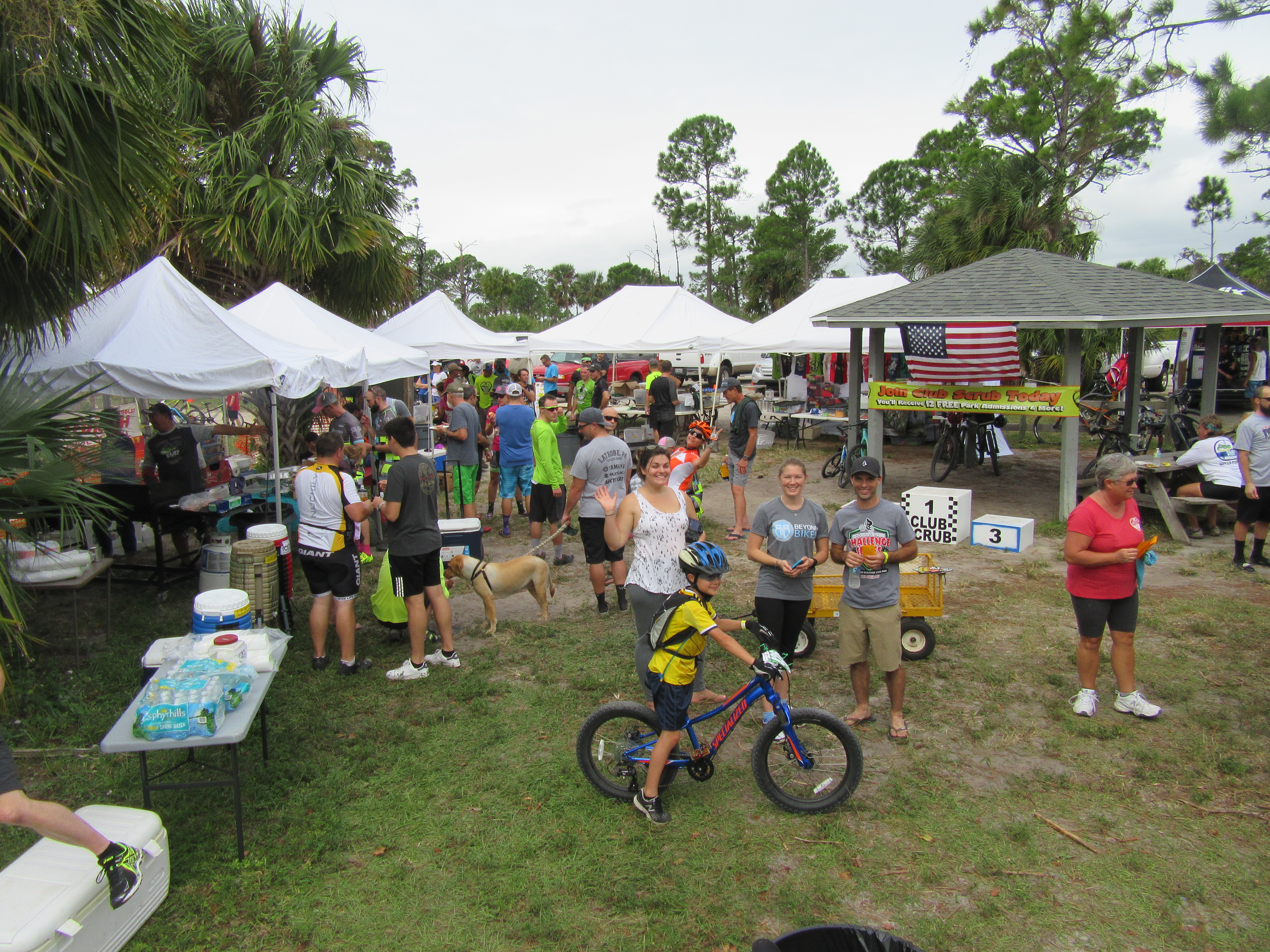
The trails are open from dawn to dusk and Helmets are required. Trail maintenance and events are all supported by the paid membership and yeoman volunteer efforts of the members of Club Scrub. Membership in Club Scrub is $40 a year and provides 12 free accesses to the Park and discounts at local business as well as all the bike shops from Vero to Broward County. For more information, go to www.ClubScrub.org or visit us on Facebook.
Swimming & Fishing
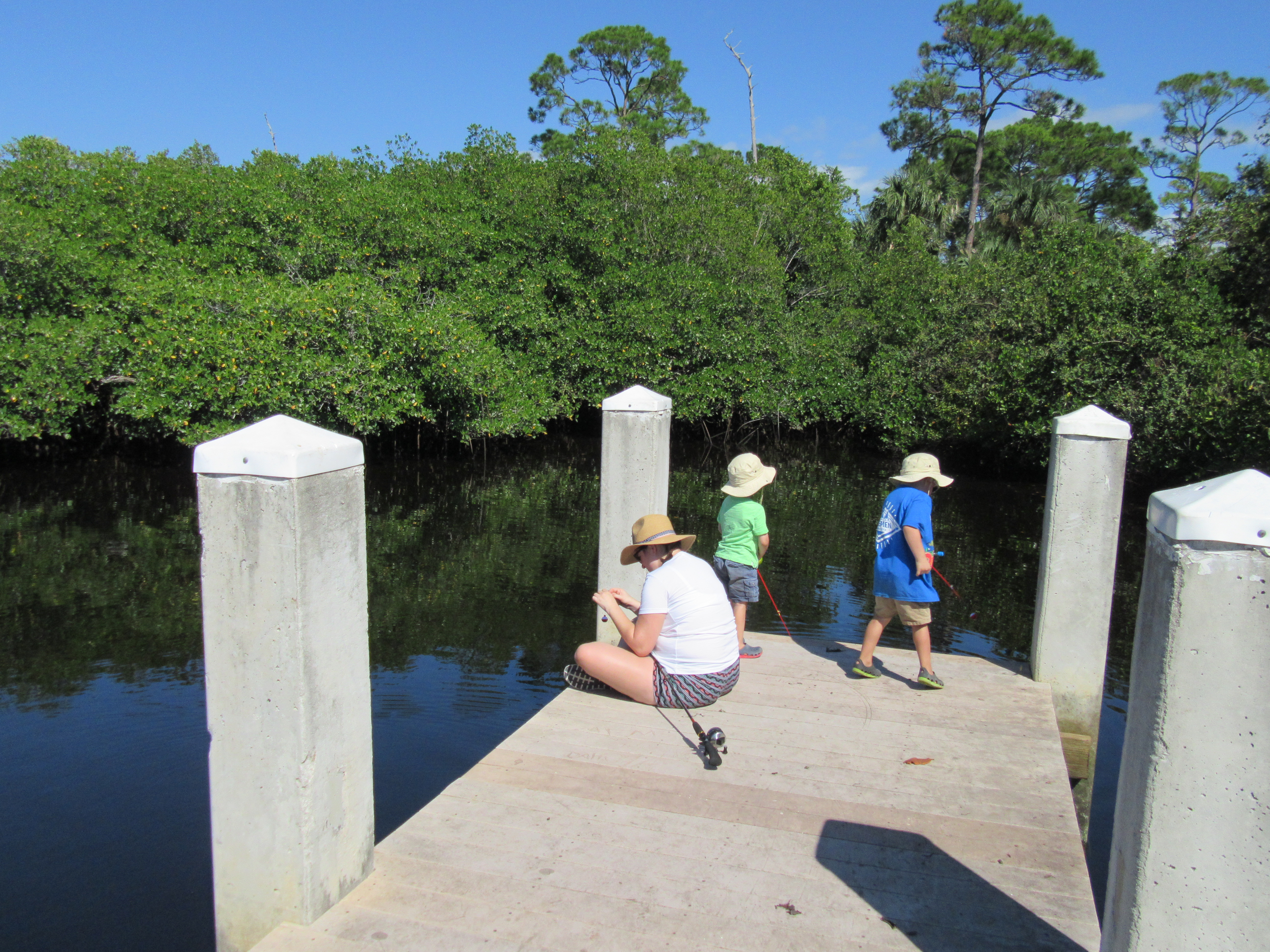
For more information on Jonathan Dickinson State Park see:
Jonathan Dickinson State Park
https://www.floridastateparks.org/park/Jonathan-Dickinson
772-546-2771
The Friends of Jonathan Dickinson State Park
www.friendsofjdsp.org
Club Scrub
www.clubscrub.org

